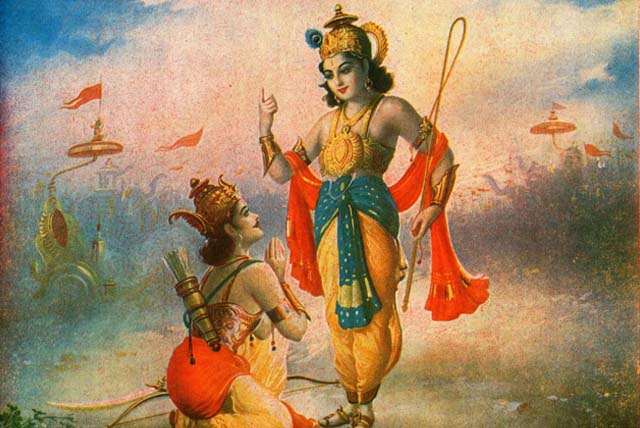The Bhagavad Gita: The Song of God

The Bhagavad Gita means The Song of God and it forms part of the epic Mahabharata. It is a sacred text of the Hindus with the essence of Vedic knowledge, and as such it is one of the most important books in Hindu international literature and philosophy.
Even though The Bhagavad Gita was written long ago its message can be helpful for us today.
Its authorship is unclear. The Song is composed of 700 Sanskrit verses contained within 18 chapters, divided into 3 sections each consisting of 6 chapters. They include: Karma Yoga (the yoga of actions), Bhakti Yoga (the yoga of devotion) and Jnana Yoga (the yoga of knowledge).
The Bhagavad Gita relates the conversation between Arjuna and Krishna during the war of Pandavas versus Kauravas competing for the throne. The main battle takes place in Kurukshetra (the field of the Kurus), which is actually Haryana in India.
Arjuna is the Pandava’s leader and a great archer. He doesn’t want to fight because his opponents are friends, teachers and relatives. But Krishna (he is the avatar of the god Vishnu), his chariot driver says to Arjuna he has to fight because it is his dharma (sacred duty) as a warrior. Finally, Arjuna decides to obey Krishna by engaging in the battle and in the end the Pandavas regain control of the kingdom.
The Bhagavad Gita combines many different elements from Samkhya and Vedanta philosophy.
In matters of religion, it’s an important contribution with emphasis placed on devotion, which has since remained a central path in Hinduism. In addition, the popular theism expressed elsewhere in the Mahabharata and the transcendentalism of the Upanishads converge, and a God of personal characteristics is identified with the Brahman of the Vedic tradition. The Bhagavad Gita thus gives a typology of the three dominant trends of Indian religion: dharma-based householder life, enlightenment-based renunciation, and devotion-based theism.
Characters
- Arjuna, the leader of the Pandavas
- Krishna, Arjuna’s charioteer and an avatar of God
- Sanjaya, counselor of the Kauravas´ king
- Dhritarashtra, Kauravas´ king
The composition by chapters
- Arjuna’s despair
- Samkhya Yoga
- Karma Yoga
- Wisdom’s Yoga
- Detachment’s Yoga
- Self-control’s Yoga
- Deep Knowledge’s Yoga
- Indestructible and eternal Brahman
- Royal Knowledge and Mystery
- Power’s Manifestation
- Contemplation of the Universal Form
- Bhakti Yoga
- The Path and the Path’s Connoisseur
- Release of the 3 Gunas (Sattva, Rajas, Tamas)
- Knowledge of the Supreme Spirit
- Discernment of the Divine and Demonic
- Threefold division of Faith
- Liberation through Renunciation
“The Gita is at once an instruction manual for living a spiritual life and a profound, ecstatic vision of the ultimate nature of God.”– Ram Dass
